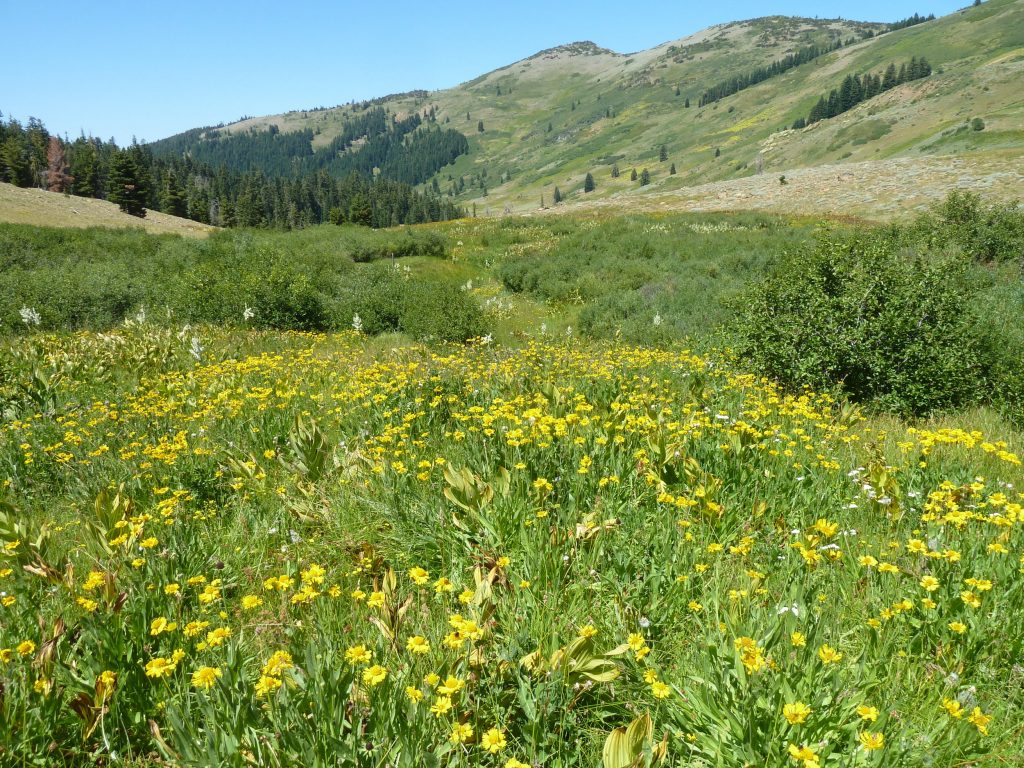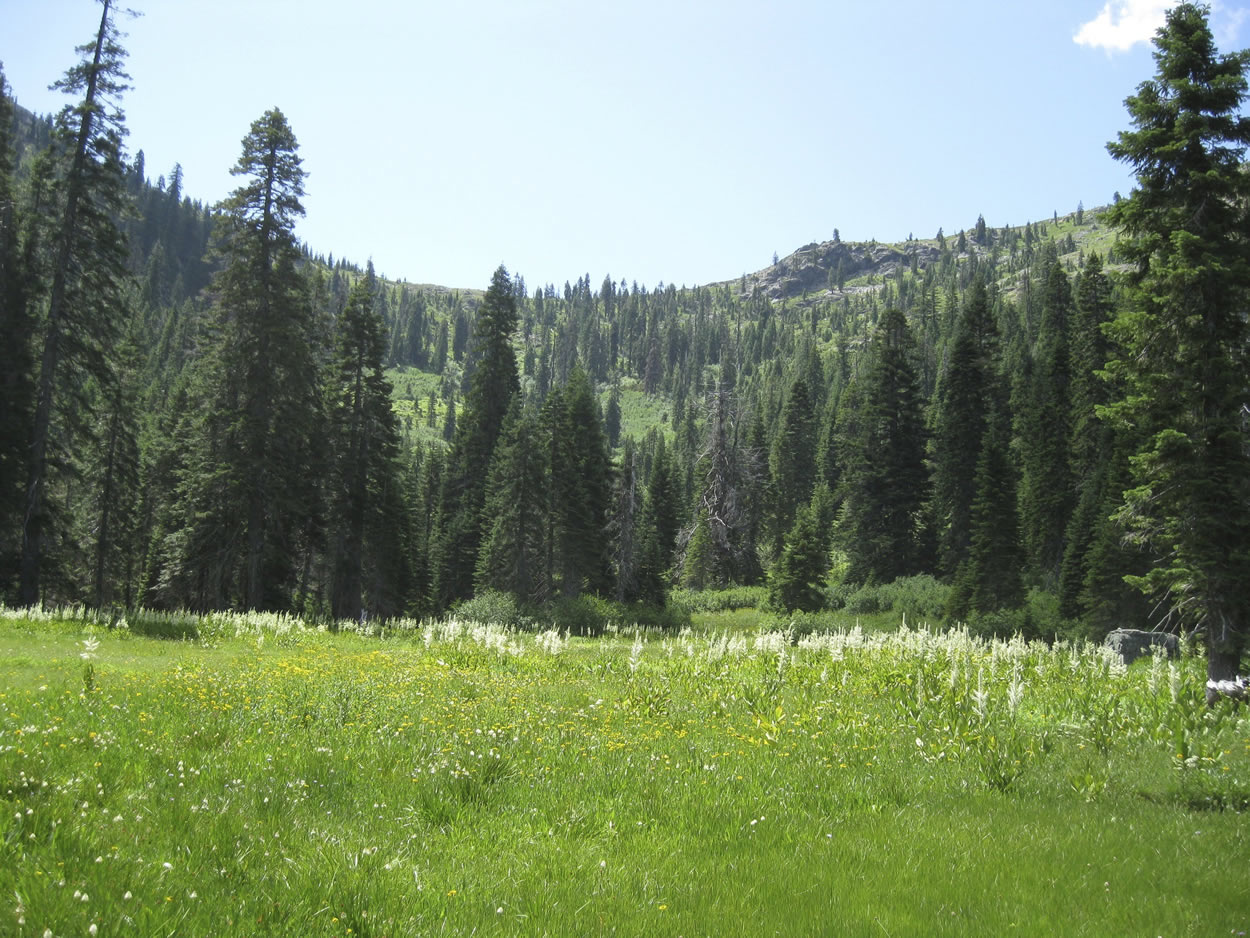
Take Action: Provide Public Comments Now!
Now is your chance to have your opinion regarding public lands grazing in the Applegate and on the Siskiyou Crest heard! The Rogue River-Siskiyou National Forest, Siskiyou Mountains Ranger District is beginning an Environmental Analysis (EA) process to update four local grazing allotments.
Applegate Grazing Complex
The proposed plan is to update four Allotment Management Plans (AMPs), collectively referred to as the Applegate Grazing Complex, including: Beaver-Silver, Carberry Creek, Elliott Creek, and Upper Big Applegate. The four allotments span across the vast majority of the Upper Applegate and Little Applegate watersheds, affecting hydrology, water quality, wildlife habitat, botanical values, roadless areas and pollinator habitat.
The Forest Service issued the Scoping Notice for the EA on February 16, 2017 and they are currently accepting public comments during the 30-day public comment period. The Scoping Notice states: “The purpose of updating the AMPs is to consider the reauthorization of livestock grazing on the four allotments. The intent of the reauthorization is to provide the Forest Service and permittees with an updated legal document that defines how livestock grazing will be managed. Grazing on the allotments have generally been permitted since the early 1900s. This effort would ensure updated information is provided for the sustained health of rangeland and forest ecosystems.
The AMPs for these allotments have not been updated since the 1960s; an evaluation of the condition and trends of vegetation and soils within the allotments needs to be conducted. Based on the results of the evaluation, the Forest Service wold either allow for continued permitted grazing for the established numbers and seasons, adjust the permitted numbers and seasons allowable for grazing, or discontinue the permitted grazing. The analysis would provide updated information that reflects current management direction and resource objectives. Updated AMPs would provide direction that maintain or improve vegetation and riparian conditions through effective livestock management while providing for other uses.”

Impacts of Public Lands Grazing in the Applegate and on the Siskiyou Crest
The Applegate Grazing Complex is located in Upper and Little Applegate watersheds and extends from the low elevation foothills to the high country of the Siskiyou Crest where most of the cows stay for the summer. Cattle routinely reach the Siskiyou Crest before the approved grazing season has begun and are often left to graze later in the season than is allowed under the current AMP, creating severe impacts and over-utilization of forage resources.
The grazing strategy currently employed is referred to as “passive season long grazing,” meaning little, if any, management occurs once the cows are placed on federal land. The cows simply manage themselves and congregate at preferred “pastures” in high-elevation wet meadows doing great damage to wetlands, streams and sensitive meadow habitat. Many sensitive habitats are being degraded or denuded by cows. Forage resources (grasses, forbs and shrubby growth) are being over-utilized by grazing cattle, leaving little for native elk and deer who prefer many of the same locations. Numerous springs, streams, wet meadows, and lakes that support populations of rare and sensitive plant species occur within the Applegate Grazing Complex.

“Livestock grazing alters the structure, diversity, and growth pattern of vegetation, which affects the associated insect community. Grazing during a time when flowers are already scarce may result in insufficient forage for pollinators. Grazing when butterfly larvae are active on host plants can result in larval mortality and high intensity grazing can cause local loss of forb abundance and diversity.” –Pollinator-Friendly Best Management Practices for Federal Lands
Much of the most intensive grazing occurs in designated Botanical Areas, established to protect botanical values; instead, grazing cattle heavily degrades many of these areas. Rare plant populations are being impacted by public land grazing and the intact habitats identified by the Forest Service for Botanical Area protection are being compacted, denuded, and mowed to the ground by unmanaged cattle grazing. Eight Botanical Areas are included within the Applegate Grazing Complex allotment boundaries: Lyman Gulch, Dutchman’s Peak, Observation Peak, Scraggy Mountain, White Mountain, Cook and Green Pass, Whisky Peak and Hinkle Lake.
Roadless Areas at the headwaters of the Applegate River are also being negatively impacted. Roadless areas within the allotment boundaries include: Observation Peak Roadless Area, Condrey Mountain Roadless Area, Kangaroo Roadless Area, and Whisky Peak Roadless Area. Low elevation roadless areas, including the Little Greyback Roadless Area, Collings-Kinney Roadless Area, Elliott Ridge Roadless Area and Boaz Mountain Roadless Areas would also be impacted by proposals to release cattle at lower elevations, allowing cattle to migrate upward as the snow melts. The release of cattle at the lower end of Mule Creek, Palmer Creek and Beaver Creek — all fish bearing streams — is proposed under the Applegate Grazing Complex Scoping Notice.
The proposal also includes grazing in the Red Buttes Wilderness, the largest intact wildland habitat in the Applegate River watershed. It has been many years since the Red Buttes Wilderness has been actively grazed.

Provide a Public Comment on the Applegate Grazing Complex
Applegate Grazing Complex Scoping comments are due on March 31, 2017.
Written comments can be sent to:
Donna Mickley, District Ranger, c/o Greta Smith
6941 Upper Applegate Road
Jacksonville, Oregon 97530.
Email comments may be submitted to:
comments-pacificnorthwest-rogueriver-siskiyoumountains@fs.fed.us
For further information about the project contact Mark Hocken, Project Team Leader, Siskiyou Mountains Ranger District: mhocken@fs.fed.us or via phone: 541-899-3830.
Sample Scoping Comment
Re: Applegate Grazing Complex Scoping Comment
Attention: District Ranger Donna Mickley c/o Greta Smith
6941 Upper Applegate Road
Jacksonville, Oregon 97530
Donna Mickley, District Ranger,
The Applegate Grazing Complex is a very significant land management project, encompassing vast acreages of federal land and creating both direct and indirect impacts across the Applegate River watershed and the Siskiyou Crest. Livestock grazing on public land is associated with widespread impacts to riparian areas, water quality, wetlands, fisheries, hydrology, native plant habitat, rare plant habitat, wildlife habitat and pollinator habitat. The scope and scale of the project requires an Environmental Impact Statement (EIS), rather than a less comprehensive Environmental Assessment (EA).
The Siskiyou Crest is a botanical wonderland and a regionally important connectivity corridor. It is one of the most significant concentrations of biological diversity on the West Coast of North America. For many years this botanical paradise has been subjected to severe overgrazing. Please consider the following substantive issues in the upcoming NEPA analysis for the Applegate Grazing Complex.
- Consider discontinuing grazing allotments on the Siskiyou Crest, especially in allotments that are not currently meeting water quality standards; in allotments that have severe stream/wetland degradation; in allotments that have significant impacts to Botanical Areas and botanical values; and in allotments that create conflicts with other appropriate uses like the Pacific Crest Trail.
- End “passive season long grazing” on the Siskiyou Crest and require all permittees to actively herd cattle from “pasture” to “pasture.” Do not allow cattle to congregate in preferred locations for more than 14 days.
- As part of the environmental review, it is essential that qualified Forest Service specialists assess stream, wetland and meadow conditions in order to determine and disclose whether streams, wetlands and meadows are functioning properly ecologically. If there are streams, wetlands and meadows on these allotments which are not functioning properly, Forest Service managers must determine how cattle grazing is impacting properly functioning condition and adjust grazing practices, including the number of livestock allowed to graze, the season of grazing at different elevations, and the grazing system that will be used to end the degradation and return streams, wetlands and meadows to properly functioning ecological condition.
- Stream, riparian and wetland exclosures should be established, and where they have been removed, they should be restored. Livestock exclosures are the only valid method to determine if grazing is significantly altering the composition and structure of riparian and wetland vegetation.
- Analysis must identify all provisions of the Clean Water Act that apply to the grazing allotments and require all grazing allotments to be consistent with the mandates of the Clean Water Act.
- Analysis must identify impacts to Botanical Areas and require that AMPs are consistent with Botanical Area designation.
- Analysis must identify impacts associated with early season grazing along low-elevation stream corridors, especially along fish bearing streams such as Beaver Creek, Mule Creek, Palmer Creek and Kinney Creek.
- Analysis must identify the impact of competition between cattle and the growing elk population on the Siskiyou Crest. Cattle numbers, seasonality of use, intensity of use and the lack of herding must address the issue of competition between cattle and elk for available forage resources.
- Analysis must identify the existing condition of willow flycatcher habitat (an agency sensitive species) in the EA, document impacts associated with cattle grazing, and limit the number of cattle or seasonality of use to mitigate impacts to willow flycatcher habitat.
- Implement the recommendations for Livestock Grazing written in the Federal publication, Pollinator-Friendly Best Management Practices for Federal Land. Utilize these guidelines for pollinator habitat and to identify impacts to pollinator habitat from grazing activities. Limit the number of cattle and seasonality of use to mitigate the impacts of grazing on pollinators. Special attention should be taken to restore, enhance and promote the maintenance of habitat for the Sierra blue butterfly (an agency sensitive species), Western bumble bee, Franklin’s bumble bee, and the monarch butterfly.
- Analyze the impact of historic grazing on dry bunchgrass habitat and in “cattle barrens” created by historic and contemporary overgrazing. Review the restoration of dry bunchgrass habitat in vacant or unused areas and compare them to areas that are actively grazed. Create guidelines within the AMPs to address the loss of historic dry bunchgrass habitat and the restoration of these communities due to non-use.
Sincerely,
[your name and address]
